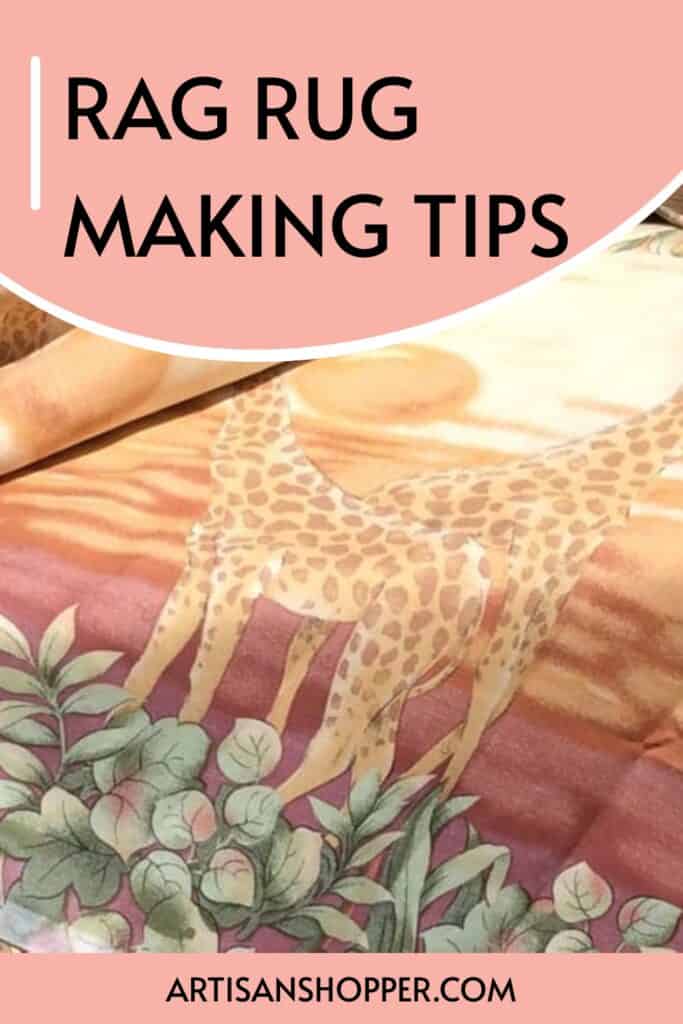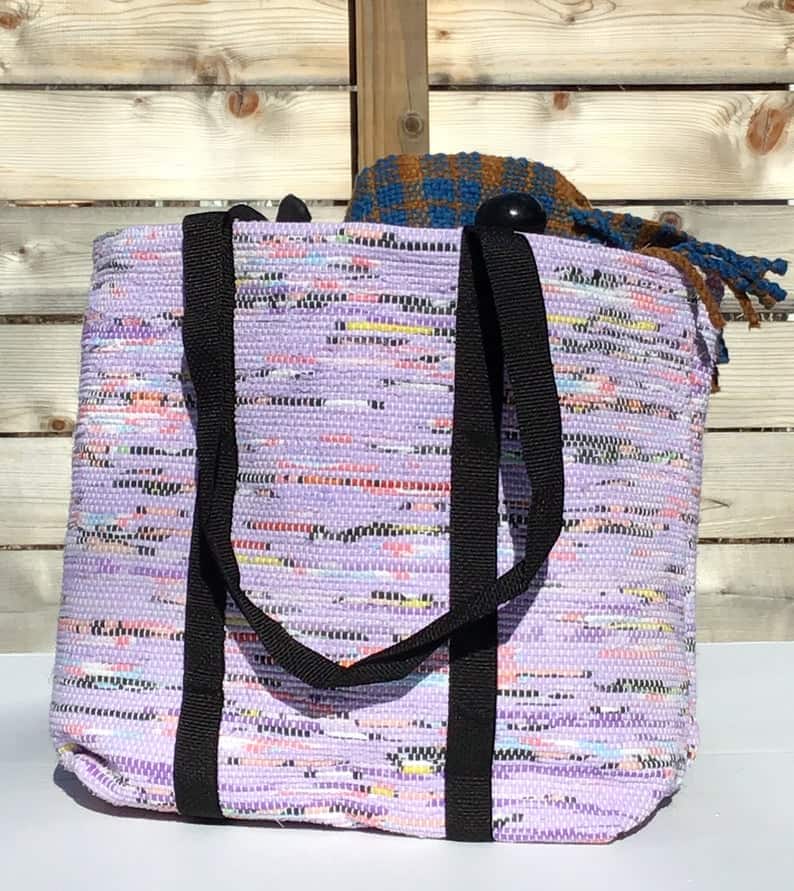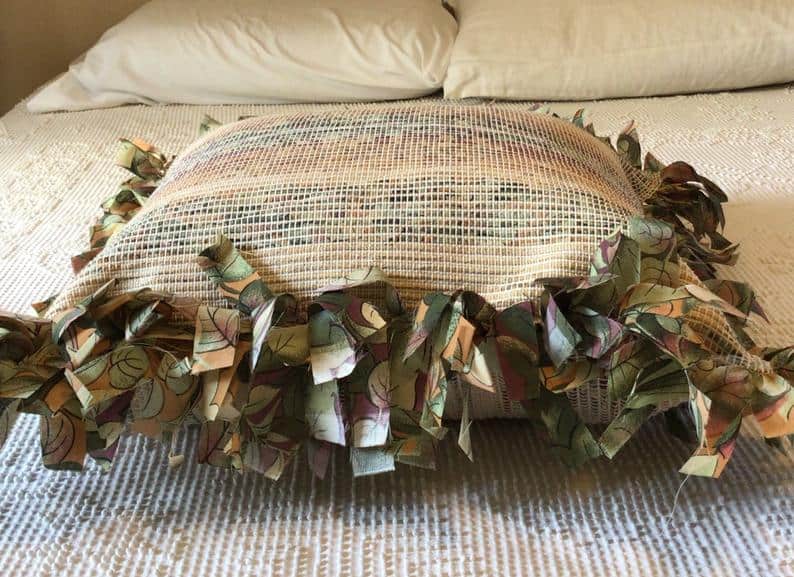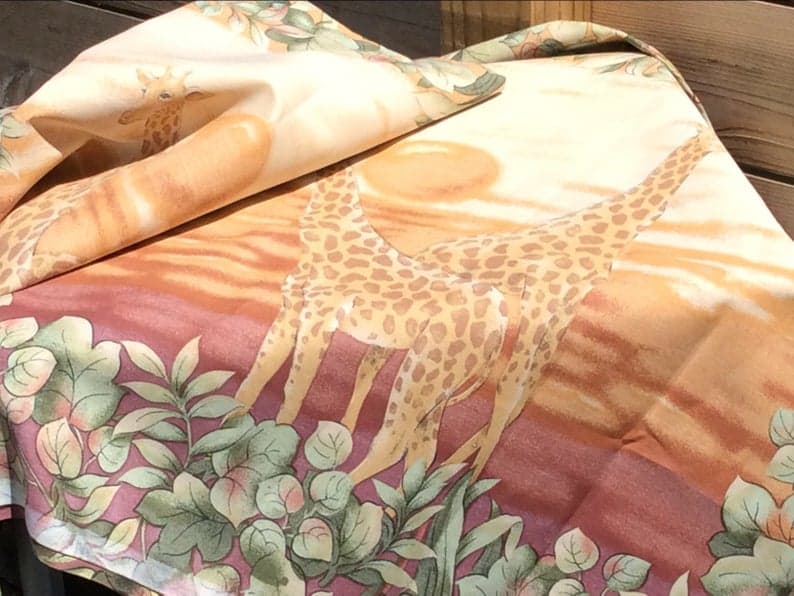Handmaking rag rugs is a craft that has been around for centuries, and is both a hobby and a way to upcycle old textiles.
When people made rag rugs in the past it was a way to avoid throwing out clothing and bedding that was worn out, but was still usable as a material for other things.
Now you can make rag rugs with old fabrics or new ones, and even with things that aren’t traditional textiles.

Whatever you use, it can be a fun way to create something usable for your home, while also being part of a zero-waste lifestyle that reuses instead of throwing things away unnecessarily.
There are many ways to create rag rugs, including weaving, knitting, crochet, and creating fabric ropes that you sew together.
Pam Lyon of Tangled Up In Blue Springs creates woven accessories from rag rug fabrics, and she wrote the article that follows.
creates woven accessories from rag rug fabrics, and she wrote the article that follows.
I’ve decided to try a knotted version of a rag rug, and the photos of that experiment will be coming soon in part 2 of this article.
I hope that reading this gives you some inspiration to go dig out the old sheets or fabric that you have stashed away to try making a rag rug for yourself!
Table of Contents
- Creating woven rag rugs as a hobby.
- Frame looms for rag rugs
- Floor looms for making rag rugs
- Where to find fabrics for rag rug weaving
Please note: Some of the links on this page are affiliate links, which will give me a small commission at no cost to you if you buy something when you use them.
Creating woven rag rugs as a hobby.
You may remember rag rugs from your childhood, and the method used to make those rugs may be what has inspired you to explore making your own rug. We’re going to look briefly at different weaving methods and materials – there is so much information available about each method that we could spend days writing about each one, but that’s not the purpose here.
Our purpose is to provide a quick overview that just might provide a pathway to the method that matches your requirements (space needed, necessary supplies, budget and portability to name a few) to get you weaving.
There are many ways to make a rag rug, so this is a hobby that anyone can give a try regardless of budget or space.
Frame looms for rag rugs
The most simple entry into weaving a rag rug is with a frame loom, which is a purchased frame with finishing nails, or a premade tapestry loom. A larger DIY loom can also be built from scrap lumber and finishing nails. The fabric strips are attached to the loom to create the warp, or the vertical strips that will hold the tension on the loom. The weft, which are the strips that are woven horizontally into the warp strips, are then added, and this process creates the woven fabric of the rug.
Other than your frame, the other supplies you will need are the fabric strips to create the warp and weft, and depending on the size of your loom, you may need a crochet hook or tapestry needle to help carry your weft.
Framed looms can be warped (the up and down threads/yarn that make up the length of your rug) with rug warp, crochet thread, kitchen string, or the same fabric strips you will be using for weft. Now that you’ve made your loom, try both and see which you prefer.
Another option for your frame loom is twining (check out YT and Pinterest for tutorials).
The key to a rag rug to be used as a rug is that it is durable, so snugly fitting each pass of weft is key to this durability.
Household tools like wide-toothed combs and forks can accomplish this task on frame looms by pressing the weft strips into the warp to make sure there’s not a lot of space between them.
Floor looms for making rag rugs
Typically, floor looms for making rag rugs are two to four shafts or harnesses, and they are larger and more stable for use in creating larger products. Floor looms take up more room than frame looms, and the cost of vintage looms can rival the cost of new models. In order to make a larger rag rug without joining smaller pieces together, a floor loom would be required.
From the late 19th century to the mid-20th century rug looms were manufactured for either in-home businesses, or to teach trades to disabled persons.
Many of the midwestern loom manufacturers sold not only under their own business names but provided Sears and other mail-order stores with looms under the store’s name.
I suggest starting with the simplest form of a hobby to make sure it’s a good fit before upgrading to the next level. Depending on the size and condition, a used rug floor loom can be found on FB Marketplace, estate sales, CraigsList, etc for under $500.
New rug looms can be found for about $2,000, not including shipping. Depending on your or your spouse’s mechanical and woodworking skills, a minimal investment (please take this loom home with you, I want my garage back) may result in other hobbies you hadn’t considered.
Creating rag rugs allows the weaver to settle into an almost meditative state as the repetition of throwing the shuttle, beating the weft into place, and changing the shed develops into a cadence that allows the weaver to slow down and fully relax into the repetitive steps of creating something new from something old.
The actual weaving part of making a rug is also a fairly quick process, so the weaver sees their vision come into focus sooner than with other crafts.
Where to find fabrics for rag rug weaving
Rag rugs have historically been made from worn out clothing and linens like bed sheets and tablecloths in order to repurpose materials. While it is possible to use new fabrics for rag rugs, making them from previously-used fabrics is a more sustainable practice. There are many sources of recycled fabrics to make rag rugs with that will contribute to a zero-waste footprint.
To start your hunt you may want to begin in your own linen closet or t-shirt collection. Are there sheets or tees that have seen better days?
Or maybe a sheet set you received as a gift that you never liked? My experience has been that the louder or just outright ugly a print, is the more interesting the resulting rug.
To keep your hunt close to home, but not strictly at home, check out online markets like FB or Craigslist. Many times when someone is re-decorating they will buy more yardage than they need “just in case,” and they are happy to sell the remaining bolt for a song.
Shop for fabric in thrift stores. For this one you may need to check back several times as you’re looking for someone who has donated their child’s outgrown cartoon character sheets and curtains, or who is de-stashing the inventory in their sewing room.
If you enjoy “junking” or going to estate sales, just add fabric to your list of things to bid on.
Once a month in Kansas City the flea markets and vintage stores that inhabit the West Bottoms (an old industrial section of town with multi-floor warehouses) are open along with almost every food truck in town.
You get lots of exercise going up and down narrow, well-worn staircases and seeing how much of a six block area you can cover before exhaustion hits.

Interior decorators also sell their deadstock (discontinued designs) and excess inventory here and the pieces are usually larger (10+ yards, instead of the two to five yards you might find at the previously discussed possibilities).
See if there is something similar in the area you live in, these are great times to catch up with friends or family – my daughter is my most reliable companion.
If you’re not going to place your finished rug on the floor, you can use it as a wall hanging or a table runner, or as fabric to make other projects. For example, I make tote bags, throw pillow covers and firewood carriers.
Don’t limit yourself to just fabric while on your hunt for supplies. I picked up a five-pound spool of dark red commercial rug yarn several years ago that I’m still using, generally with VHS tape. While not a choice for using on the floor, fabric made from VHS tape makes great lightweight tote bags that can be machine washed.
You can pick old tapes up from almost any garage sale and you may find many of your friends and family would send you home with boxes of tapes, just to get them out of their houses. I already have a lifetime supply, thank you.
I’ve seen ornamental grasses used to provide interesting texture, so don’t pass up free or low-cost supplies just because they’re not conventional, this is your hobby. Use what you find interesting or novel. Mainly, just have fun.
Thanks to Pam for giving us the basics on loom weaving rag rugs…You can obviously also use the fabrics that you create for other projects. Make sure to check out Pam’s Etsy shop with her handmade woven items here: Tangled Up In Blue Springs
To see the other home decor items from Artisan Shopping Directory members, click here: Home and Living, Art and Collectibles, Vintage Finds
For part two of the rag rugs articles, click here: Amish Knot Rag Rugs, Tips For Beginners


